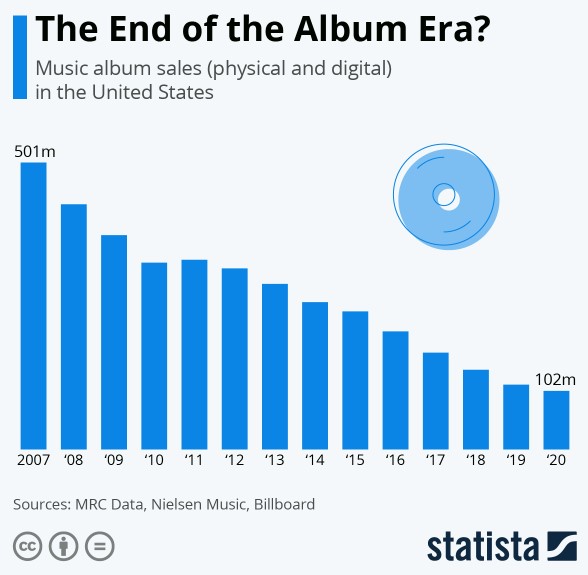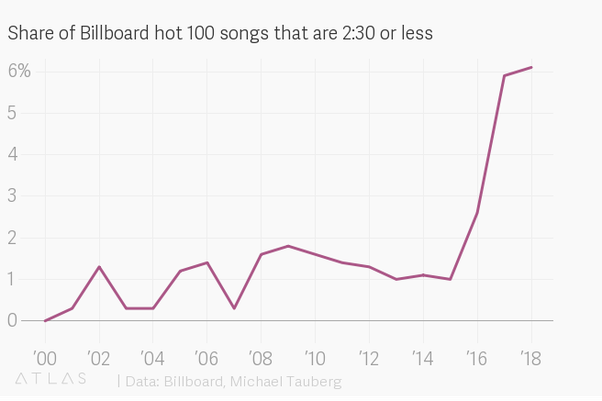Along with the technological changes, our way of listening to music also has changed in the last three decades. How do the changes affect musicians and the music industry? and what are the changes? and what does the change imply?
Significant changes were made by the transition from physical albums to digital music, and to music streaming services. Due to these changes, over the past two decades, we have encountered a decline in the sales of physical albums while witnessing an increase in the consumption of digital music formats.

Not only the digitization of music but also the newly-imposed music distribution infrastructure changed the music industry.
While people were mainly downloading music and having them on their devices in the past, now most people are using music streaming services. Here, there are significant differences between music downloading and music streaming. Music streaming service is based on subscription. That is to say, during the subscription you can access all music on the platform. This is different from that, as you download music, you pay per song. (If you don’t use piracy) Therefore, downloading music is in the form of ownership-based consumption, whereas subscribing to music stream service is in the form of access-based consumption.
How the music streaming service has reshaped the music-making process and music industry.
First, I want to talk about the revenue model of music streaming services. Music streaming services pay artists less than what they earn from CDs, concerts, and other merchandise. For instance, one of the world’s biggest music streaming services, Spotify pays artists between $0.003 – $0.005 per stream on average. Since the money that musicians would get per song on CD is $0.25, the $0.003 – $0.005 is relatively too small. As an outcome of this revenue model, many musicians are inclined to minimize the length of the song in the composing process. Because no matter how long the music will be, they will get $0.003 – $0.005 per streaming.

Another significant change has been brought about by the custom playlist function. You can customize your own playlist on the music streaming services and it has individualized the listening experiences. In the past, the order of the songs in an album was one of the most crucial factors, since it guides audiences to the certain narratives that musicians intend. Therefore, many musicians were deeply considering the order of their music. However, the significance of this order has been loosened due to the custom play function. Now, users are making their own playlists with their own preferences. Therefore the meaning of an album as a big unit narrative is slowly gone.
What is the future of music streaming services?
Recently, music streaming services have become more than mere music distributing/ sharing platforms. For instance, on the 22nd of September of 2022 Spotify launched a new service called GetReadyWithMusic, which makes the playlist based on people’s outfits. This GetReadyWithMusic is based on the questionnaire that the user filled in. It asks the text, color, and form of their outfit to generate a playlist. After that, by analyzing the questionnaire answer, algorithms would suggest the playlist. Once the playlist has been generated, users can upload their outfit photo as the playlist’s cover image. This playlist can also be shared through other SNS platforms besides of within Spotify.
Apart from these new services, many music streaming services try to incorporate more interactive elements into their platform. Although we don’t know yet what this new Spotify service would do in the music industry, we know this would affect how people would engage with music. This recent trend of interaction in music streaming service foster the question of what kind of new interactive elements will be updated to the existing music streaming service and how they would affect people’s way of listening. Furthermore, that would affect the music industry and musicians’ music-making process.
Because changes in platform bring changes in the contents of the platform and vice versa.
References
Chart: The End of the Album Era? | Statista
How to Use Spotify’s New ‘Get Ready With Music’ Playlist (businessinsider.com)


I’m curious about the thing you said about the average length of a Billboard 100 song, are there no other reasons why the songs are getting shorter? People always seem to mention that the attention span of people are getting shorter by the year.
Maybe its also worth investigating the strategy behind the song structure of Old Town Road by Lil Nas X because I heard that this song in particular abuses this system to get more streams. I might be writing an blogpost about it myself now that I think about it!